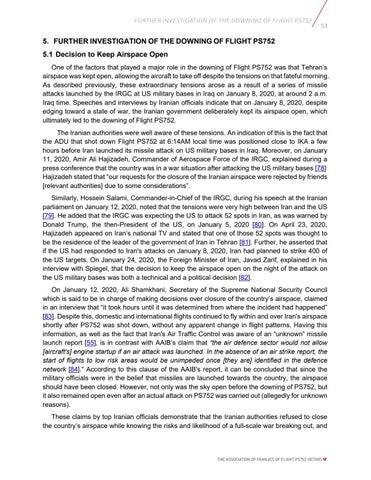53
5. FURTHER INVESTIGATION OF THE DOWNING OF FLIGHT PS752 5.1 Decision to Keep Airspace Open One of the factors that played a major role in the downing of Flight PS752 was that Tehran’s airspace was kept open, allowing the aircraft to take off despite the tensions on that fateful morning. As described previously, these extraordinary tensions arose as a result of a series of missile attacks launched by the IRGC at US military bases in Iraq on January 8, 2020, at around 2 a.m. Iraq time. Speeches and interviews by Iranian officials indicate that on January 8, 2020, despite edging toward a state of war, the Iranian government deliberately kept its airspace open, which ultimately led to the downing of Flight PS752. The Iranian authorities were well aware of these tensions. An indication of this is the fact that the ADU that shot down Flight PS752 at 6:14AM local time was positioned close to IKA a few hours before Iran launched its missile attack on US military bases in Iraq. Moreover, on January 11, 2020, Amir Ali Hajizadeh, Commander of Aerospace Force of the IRGC, explained during a press conference that the country was in a war situation after attacking the US military bases [78]. Hajizadeh stated that “our requests for the closure of the Iranian airspace were rejected by friends [relevant authorities] due to some considerations”. Similarly, Hossein Salami, Commander-in-Chief of the IRGC, during his speech at the Iranian parliament on January 12, 2020, noted that the tensions were very high between Iran and the US [79]. He added that the IRGC was expecting the US to attack 52 spots in Iran, as was warned by Donald Trump, the then-President of the US, on January 5, 2020 [80]. On April 23, 2020, Hajizadeh appeared on Iran’s national TV and stated that one of those 52 spots was thought to be the residence of the leader of the government of Iran in Tehran [81]. Further, he asserted that if the US had responded to Iran's attacks on January 8, 2020, Iran had planned to strike 400 of the US targets. On January 24, 2020, the Foreign Minister of Iran, Javad Zarif, explained in his interview with Spiegel, that the decision to keep the airspace open on the night of the attack on the US military bases was both a technical and a political decision [82]. On January 12, 2020, Ali Shamkhani, Secretary of the Supreme National Security Council which is said to be in charge of making decisions over closure of the country’s airspace, claimed in an interview that “it took hours until it was determined from where the incident had happened” [83]. Despite this, domestic and international flights continued to fly within and over Iran's airspace shortly after PS752 was shot down, without any apparent change in flight patterns. Having this information, as well as the fact that Iran's Air Traffic Control was aware of an “unknown” missile launch report [55], is in contrast with AAIB’s claim that “the air defence sector would not allow [aircraft's] engine startup if an air attack was launched. In the absence of an air strike report, the start of flights to low risk areas would be unimpeded once [they are] identified in the defence network [84].” According to this clause of the AAIB's report, it can be concluded that since the military officials were in the belief that missiles are launched towards the country, the airspace should have been closed. However, not only was the sky open before the downing of PS752, but it also remained open even after an actual attack on PS752 was carried out (allegedly for unknown reasons). These claims by top Iranian officials demonstrate that the Iranian authorities refused to close the country’s airspace while knowing the risks and likelihood of a full-scale war breaking out, and








